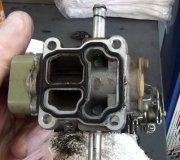Try blocking the fresh air tube before the mass air flow sensor, if possible. If the engine continues to run, it has to be getting air from someplace else, and you have to figure out where.
If the engine stalls when you do that, the next step would be to connect a scanner that displays live sensor data while the engine is running. Of particular interest is the idle air control motor, (IAC). The Engine Computer sets that motor to various positions to open an air valve that lets air bypass the throttle blade. At the same time, it changes the amount of time it holds the injectors open during each pulse. That's how it controls idle speed. The IAC will be shown as a percentage or as the number of "steps" from 0 to 256. The higher the step or the higher the percentage, the higher the idle speed is being commanded to.
If you find the step real low, say below 25, the computer knows the idle speed is too fast and is trying unsuccessfully to reduce it. The IAC itself could be the cause. Electrically it is okay, otherwise the Engine Computer would detect the problem, set a fault code in memory, and turn on the Check Engine light, but carbon buildup could be preventing the motor / valve from responding properly.
If the step or percentage is real high, the computer is trying to raise idle speed in response to some other sensor reading. It usually takes an experienced mechanic to interpret those other sensor readings and to find the cause of the high idle speed. Ford had a lot of erratic idle speed problems caused by defective coolant temperature sensors. Idle speed is raised when the engine is cold, and the Engine Computer tried to respond to varying readings coming from that sensor.
With all of these things, it's still real hard to hit 6,000 rpm. Most engines will have severe "valve float" and misfires long before that speed is reached. Most manufacturers have gone to the insanely dangerous "throttle-by-wire" system that replaces the simple, reliable throttle cable with a computer, motor-driven throttle blade, and two position sensors. That is the system that put Toyota in the news last year, just like we predicted. If you have that system, leave the repairs all to the dealer. You don't want to become a party to any future lawsuits by tinkering with it yourself.
Sunday, October 30th, 2011 AT 9:42 PM


